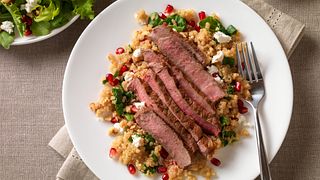Beef. It’s What’s For Dinner. Dishes Up New Ads Addressing Common Myths About Beef
Autumn Velez| february 5, 2020
New ads tackle the topics of health, sustainability and meat substitutes with the iconic brand’s unique personality and swagger
Beef. It’s What’s For Dinner., managed by the National Cattlemen’s Beef Association, a contractor to the Beef Checkoff, is addressing common questions and hot topics in the beef industry head-on with the launch of new digital and social media ads. The ads focus on the topics of sustainability, health and meat substitutes.
Staying true to the brand’s notable swagger, the ads leverage the popular “Nicely done, beef” creative wrapper to directly address misinformation while highlighting beef’s strongest attributes – taste, quality, health sustainable production.
“This year the Beef. It’s What’s For Dinner. Checkoff-funded programs are focused on continuing to drive demand for beef by re-enforcing that real beef’s great taste and nutrition that cannot be replicated and directly addressing myths that may affect consumer decisions to choose beef,” said Laurie Munns, a cattle rancher from Hansel Valley, Utah and Federation Division Chairman, at the National Cattlemen’s Beef Association “To achieve this, we are leaning on checkoff funded technical research and focusing on the real facts about real beef.”
The new series of ads are currently running on Facebook, Instagram and Twitter, and Beef. It’s What’s For Dinner. will continue to roll out additional creative elements such as video, programmatic and native advertising in the weeks ahead.
The ads directly target older millennial consumers, especially parents, directing them back to BeefItsWhatsForDinner.com where they can learn about beef’s powerful nutrition and sustainability stories, and find beefy mealtime inspiration.
“As a contractor to the Beef Checkoff, we are using the dollars of beef farmers and ranchers to ensure consumers, media, chefs, dietitians and food service and retail partners have the facts when it comes to beef,” Alisa Harrison, senior vice president, Global Marketing & Research. “It’s important to keep in mind that consumers crave real beef and meat alternatives represent less than 1 percent market share, while real beef represents more than 99% market share or sales at retail and foodservice. While these products aren’t replacing beef, we still want to ensure people are choosing their proteins based on facts and not fear-based misinformation.”
These ads are just latest in the “Nicely done, beef.” series, which were first released in early 2018. One of the original, “Nicely done, beef.” ads, which says “Nicely done, beef. You prove that meat substitutes are just that. Substitutes.” has more than 53 million impressions since it was launched and has resulted in more than 286,000 clicks back to the BeefItsWhatsForDinner.com website. In 2019 alone, Beef. It’s What’s For Dinner. marketing efforts, including the Nicely done ads, have reached consumers more than 1 billion times.
“As consumers have an increasing interest in where their food comes, the nutrients it provides and how to prepare it in new and innovative ways, the Beef. It’s What’s For Dinner. brand will continue to serve as an informative, convenient and mouthwatering resource,” said Season Solorio, senior executive director, Brand Marketing and Communications. “Thanks to these ongoing efforts, consumers can continue to feel good about choosing beef for the center of their plates.”
About the Beef Checkoff
The Beef Checkoff Program was established as part of the 1985 Farm Bill. The checkoff assesses $1 per head on the sale of live domestic and imported cattle, in addition to a comparable assessment on imported beef and beef products. States may retain up to 50 cents on the dollar and forward the other 50 cents per head to the Cattlemen's Beef Promotion and Research Board, which administers the national checkoff program, subject to USDA approval.
About NCBA, a Contractor to the Beef Checkoff
The National Cattlemen’s Beef Association (NCBA) is a contractor to the Beef Checkoff Program. The Beef Checkoff Program is administered by the Cattlemen’s Beef Board, with oversight provided by the U.S. Department of Agriculture.






